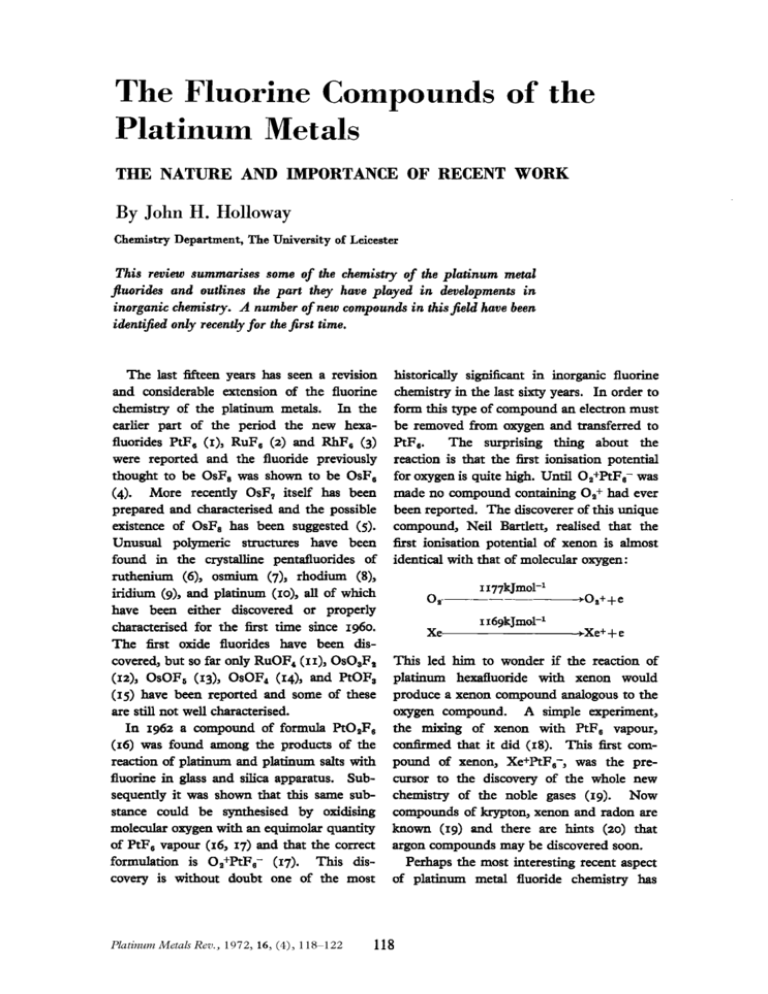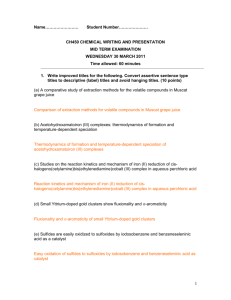The Fluorine Compounds of the Platinum Metals
advertisement

The Fluorine Compounds of the Platinum Metals THE NATURE AND IMPORTANCE OF RECENT WORK By John H. Holloway Chemistry Department, The University of Leicester This review summarises some of the chemistry of the platinum metal fluorides and outlines the part they have played in developments in inorganic chemistry. A number of new compounds in thisjeld have been identijed only recently for the j r s t time. The last fifteen years has seen a revision and considerable extension of the fluorine chemistry of the platinum metals. In the earlier part of the period the new hexafluorides PtF, (I), RuF, (2) and RhF, (3) were reported and the fluoride previously thought to be OsF, was shown to be OsF, (4). More recently OsF, itself has been prepared and characterised and the possible existence of OsF, has been suggested (5). Unusual polymeric smctures have been found in the crystalline pentduorides of ruthenium (6), osmium (7), rhodium (8), iridium (g), and platinum (10),all of which have been either discovered or properly characterised for the first time since 1960. The first oxide fluorides have been discovered, but so far only RuOF, (11), Os09F, (12), OsOF, (13), OsOF, (14), and PtOF, (IS) have been reported and some of these are still not well characterised. In 1962 a compound of formula ROBF, (16)w a s found among the products of the reaction of platinum and platinum salts with fluorine in glass and silica apparatus. Subsequently it was shown that this same substance could be synthesised by oxidising molecular oxygen with an equimolar quantity of PtF, vapour (16,17) and that the correct formulation is Oa+PtF,- (17). This discovery is without doubt one of the most Platinum Metals Rev., 1972, 16, (4), 118-122 historically significant in inorganic fluorine chemistry in the last sixty years. In order to form this type of compound an electron must be removed from oxygen and transferred to RF,. The surprising thing about the reaction is that the first ionisation potential for oxygen is quite high. Until 02+PtF6-was made no compound containing 02+ had ever been reported. The discoverer of this unique compound, Neil Bartlett, realised that the fist ionisation potential of xenon is almost identical with that of molecular oxygen: Op I 177kJmol-l -Oa+ I 16glcJmol-l Xe :-e +- *Xe+ e This led him to wonder if the reaction of platinum hexafluoride with xenon would produce a xenon compound analogous to the oxygen compound. A simple experiment, the mixing of xenon with PtF, vapour, d m e d that it did (18). This first compound of xenon, Xe+PtF,-, was the precursor to the discovery of the whole new chemistry of the noble gases (19). Now compounds of krypton, xenon and radon are known (19) and there are hints (20) that argon compounds may be discovered soon. Perhaps the most interesting recent aspect of platinum metal fluoride chemistry has 118 Fig. 1 The hexajuorides of the platinurn mads are highly volatile and er- tremely corrosive. Consequently their discovery awuited the deuelopment of special Mend and nickel uacuum and high-pressure systems for handling them under anhydrous conditions and such apparatus is shown here been the discovery of a new class of compounds, the transition metal carbonyl fluorides. Carbonyl fluorides of molybdenum (21) and ruthenium (22) have been claimed but only the ruthenium compound, difluorotricarbonylruthenium(I1) (22) has been fully characterised and this has been shown to have a closely related structure to those of the platinum metal pentafluorides (see later). Binary Fluorides Because the six platinum metals are usually referred to as a single “group”, it is often assumed that they are chemically similar. Platinum Metals Rev., 1972, 16, (4) The variety of types of oxide fluoride and the fact that oxide fluorides are known only for three metals are indications that this is not the case. In fact, the chemistry of the platinum metals is quite diverse. This is well illustrated by the fluorides, and trends are best determined by considering the elements as members of the second and third transition series (See Table I). As is usual with transition elements each exhibits a variety of oxidation states. Through the series up to the first members of Group VIII the highest attainable oxidation state is equal to the group number. Ruthenium and osmium both exhibit octavalence in their 119 Table I The Platinum Metals as Members of the Second and Third Transition Series Group Element IIIA IVA VA VIA VIIA Y Zr Nb Mo Tc Ru Rh Pd Ag La Hf Ta W Re 0s Ir Pt Au VIII IB Electronic Configuration Element Electronic Configuration 5d16s2 5d26s2 5d36s3 5d46s2 5d56sz gd66s2 5d76sZ 5d96s15d106s1 tetroxides and some hint of the existence of OsF, has also been obtained (5). Beyond these first members of Group VIII, however, the oxidation state maximum diminishes dramatically from Ru to Ag and from 0 s to Au in spite of the availability of the necessary numbers of valence electrons. There is no firm evidence for Rh(1X) and Ir(1X) compounds or for decavalent palladium or platinum. Indeed, even hepta- and octavalent states for the elements beyond ruthenium and osmium have not been attained. In Table I1 the known fluorides and oxide fluorides of the platinum metals are listed along with the highest oxidation-state oxides. A number of interesting features are at once apparent. For example, although RhF, is known Rho, is not; the highest known fluoride of ruthenium is RuF, in spite of the fact that RuO, exists. Some explanations for observations such as these have been derived from thermodynamic considerations (23). In 1966, Glemser and his co-workers ( 5 ) succeeded in preparing OsF, by heating osmium plus fluorine mixtures at high temperatures (500 to 600°C) and pressures (350 to 400 atm.). As expected the pale yellow compound loses fluorine at room temperature to give OsF,. Osmium hepta- Octafluorides and Heptafluorides In spite of the demise of so-called “OsFs” in 1958 (4) there has always been hope that a higher osmium fluoride than OsF, might be formed since, unlike RuF,, OsF, is stable and the preceding element in the third transition series forms a heptafluoride, Platinum Metals Rev., 1972, 16, (4) J 20 Table II The Known Fluorides and Oxide Fluorides of the Platinum Metals and the Highest Oxidation-state Oxides I R u RuF, RuF, RuF, RuF, Rh RhF, RhF5 RhF, RhF, RuOF, RuO, 0 s OsF, OsF, OsF, OsF, PdF, PdF, PdF, Pd,O, Rho, Ir Pt IrF, IrF, IrF, IrF, OsO,F, PtF, PtF, PtF, PtOF, OsOF, OsOF, oso, IrO, PtO, fluoride was shown to have a pentagonal bipyramidal (D5h symmetry) structure. During these experiments mass spectrometric, magnetic susceptibility, e.s.r. and i.r. evidence was accumulated which suggested the possible existence of some OsF, in the reaction product. However no conclusive evidence for OsF, has yet been obtained. n Hexafluorides The discovery of the hexafluorides RuF, 0 - F ( 4 ) ~~ F (3hGand PtF6 (1) was I the work of one research group under the Fig. 2a (above) leadership of Bernard Weinstock at Argonne Fig. 26 (below) National Laboratory in the U.S.A. Their success came largely through their development of special Monel and nickel vacuum and high-pressure systems for the handling of these highly volatile and corrosive materials. (Similar apparatus is shown in Fig. I.) With the exception of palladium then, a hexafluoride is known for each of the platinum metals. The physical properties of some of these molecules have been carefully studied but very little is known of their chemistry (24, 25). Although there are no good heat of formation data available, fundamental vibration frequencies for the algmode in the infrared and Raman spectra (26, 23) indicate a decrease in bond strength from left to right in Fig. 2 ( a ) Tetrameric crystalline pentajuorides of each series and this is confirmed by the the platinum metals with metal atoms M at the corners of a rhombus and with non-linear bridging increasing tendency for the hexafluoride to jhorine atoms between the metals. F=$uorine atom dissociate to lower fluoride and fluorine with ( b ) The tetramer from the side showing clearly increasing atomic number. This decrease in the close packed layers of fluorine atoms stability has been explained in terms of there being an increase in the electron withdrawing The structures are based on a hexagonal power of the central atom across each series close-packed arrangement of fluorine atoms, and the tetramer seen from the side clearly (23). shows the close packed layers of fluorine Pentafluorides and Lower Fluorides atoms (see Fig. zb). Unusual tetrameric structures were disOther recent interesting aspects of platinum covered in the crystalline pentafluorides of metal pentafluoride chemistry include adduct Ru (6), 0 s (71, Rh (81, Ir (9), and Pt (10) formation of RuF, and OsF, with XeF,. The (see Fig. za) in the early 1960s. In these MFj.XeF,, MF,.(XeF,), (M=Ru or 0 s ) tetramers the metal atoms lie at the corners and (RuF,),.XeF, adducts are known and of a rhombus and there are non-linear may be prepared in BrF, solution (28) or, bridging fluorine atoms between the metals. in most cases, directly from the parent (2)~ OsF6 Platinum Metals Rev., 1972, 16, (4) ~ 121 fluorides (27). X-ray evidence on the OsF,. (XeF,), compound has been interpreted on the basis of an ionic formulation containing the XeeF,+ cation (28) and it has been assumed that the remaining adducts can be formulated in terms of similar ionic adducts [XeF]+[MF,]- or [XeF]+[M,F,,]-. Generally speaking the lower fluorides can be most readily prepared when the related higher fluorides are least stable, e.g., PdF, is known but PdF, has not been made; attempts to make PtF, and PtF, have failed (29). Little is known of the properties of these compounds though the structures for some of the trifluorides are known (30) and the “trifluoride” of palladium has been shown to be PdZ+[PdF,]2-, palladium(I1) hexafluoropalladate(1V) (3I). Complex Fluorides Bartlett has drawn much attention to the reactivity of the higher fluorides of the platinum metals by reference to their complex formation with such things as nitric oxide (23). He has shown that the electron affnity of the hexafluorides increases with atomic number and that PtF, is the only hexafluoride capable of oxidising oxygen (i.e. to give 02+PtF,- (17)). This correlates well with the increased readiness of hexafluorides to dissociate to fluorine and a lower fluoride with increasing atomic number. He has also shown that the quinquevalent state is increasingly difficult to attain as atomic number is increased across each series, as the following reactions illustrate (23). 6CsBr+60sBr4 I 1zBrF,+6Cs0sF~ I 21Br, 6CsBr+6IrBr,+ 1zBrF,+6Cs1rF, t 21Br, Cs,PtBr, -2BrF3+Cs,PtF6 +4Br, 2CsBr 1 2Ru+4BrF3+zCsRuF,+ 3Br, 4CsC1 t 2RhC1,+~BrF,+2CszRhF,+2Brz t5CL 2CsBr : PdBr, 12BrF,+CszPdF, i 3Brz In fact, this decrease in the maximum attainable oxidation state with increasing atomic number parallels the case of the simple fluorides. Platinum Metals Rev., 1972, 16, (4) References B. Weinstock, H. H. Claassen and J. G. Malm, J . Am. Chem. Soc., 1957, 79, 5832 2 H. H. Claassen, H. Selig, J. G. Malm, C. L. Chernick and B. Weinstock, J . A m . Chem. Soc., 1961, 83, 2390 3 C. L. Chernick, H. H. Claassen and B. Weinstock, J . Am. Chem. Soc., 1961, 83, 3165 4 B. Weinstock and J. G. Malm,J. Am. Chem. Soc., 1958, 80, 4466 5 0. Glemser, H. W. Roesky, K. H. Hellberg and H. U . Werther, Chem Ber., 1966,99,2652 6 J . H. Holloway, R. D. Peacock and R. W. H. Small, J . Chcm. Soc., 1964,644 7 S. J. Mitchell and J. H. Holloway, J . Chem. Soc. (A),1971, 2789 8 J. H. Holloway, P. R. Rao and N. Bartlett, Chem. Comm., 1965, 306 9 N. Bartlett and P. R. Rao, Chem. Comm., 1965,252 I 0 N. Bartlett and D. H. Lohmann, J . Chem. SOC., 1962, 5253 I1 J. H. Holloway and R. D. Peacock,J. Chem. Sot., 1963, 527 I2 M. A. Hepworth and P. L. Robinson, 3. Xnorg. Nuclear Chem., 1957,4,24 I3 N . Bartlett, N. K. Jha and J. Trotter, Proc. Chem. Soc., 1y58,80,4466 I4 G. B. Hargreaves and R. D. Peacock, J . Chem. Soc., 1960, 2618 15 N. Bartlett and D. H. Lohmann, J , Chem. SOC.,1964,619 16 N. Bartlett and D. H. Lohmann, Proc. Chem. Soc., 1962,115 I7 N. Bartlett and D. H. Lohmann, J . Chem. Sac., 1962, 5253 18 N. Bartlett, Proc. Chem. Soc., 1962, 218 I 9 J. H. Holloway, “Noble-Gas Chemistry”, Methuen, London, 1968 20 J. Berkowitz and W. A. Chupka, Chem. Phys. Lett., 1970,7,447 21 T. A. O’Donnell and K. A. Phillips, Znorg. Chem., 1970~9,2611 22 C. J. Marshall, R. D. Peacock, D. R. Russell and I. L. Wilson, Chem. Comm., 1970, 1643 23 N. Bartlett in “Preparative Inorganic Reactions”, Vol. 2, Ed. W. L. Jolly, Interscience, New York, 1965 24 J. E. Canterford, R. Colton and T. A. 0’ Donnell, Rev. Pure Appl. Chem., x967,17,123 25 T. A. O’Donnell, Rev. Pure Appl. Chem., 1970, 20, I59 26 H. H. Claassen, G. L. Goodman, J. H. Holloway and H. Selig, J . Chem. Phys., 1970, 53,341 27 J. H. Holloway and J. G. Knowles,J. Chem. Sot. (A), 1969, 756 28 F. 0. Sladky, P. A. Bulliner and N. Bartlett, J. Chem. Soc. ( A ) , 1969, 2179 29 N. Bartlett and D. H. Lohmann, J . Chem. SOC.,1964, 619 30 M. A. Hepworth, K. H. Jack, R. D. Peacock and G. J. Westland, Actu Cryst., 1957, 10,63 31 N. Bartlett and P. R. Rao, Prac. Chem. SOC.,1964,393 122 I






